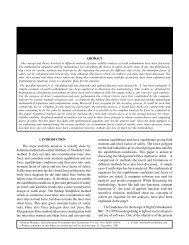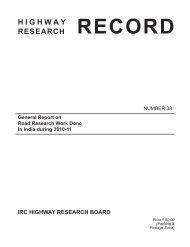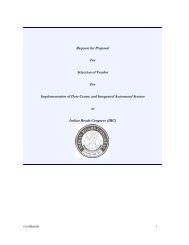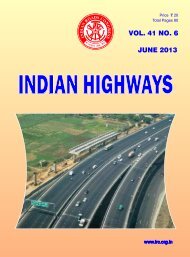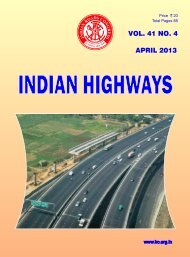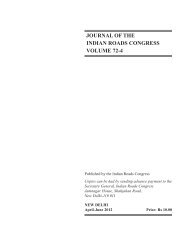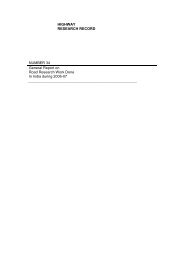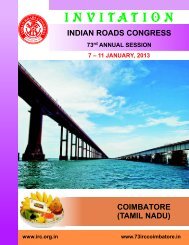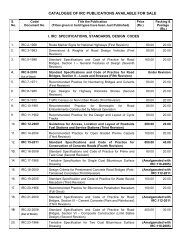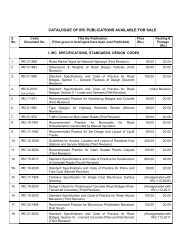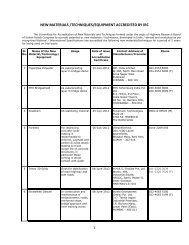Highway Research Record No. 39 - Indian Roads Congress
Highway Research Record No. 39 - Indian Roads Congress
Highway Research Record No. 39 - Indian Roads Congress
You also want an ePaper? Increase the reach of your titles
YUMPU automatically turns print PDFs into web optimized ePapers that Google loves.
ROAD RESEARCH IN INDIA 2011-12 31<br />
II. GEOTECHNICAL ENGINEERING<br />
SUMMarY<br />
The projects reported in the Geotechnical Engineering area relate to landslide hazard mitigation, Guidelines on<br />
landslide Management on <strong>Indian</strong> <strong>Roads</strong> and <strong>Highway</strong>s, Site Stabilisation work, Use of jute geotextiles in PMGSY<br />
roads to study efficacy of Jute Geotextile (JGT) and utilization of various solid industrial wastes in road works. Waste<br />
materials have been evaluated in the laboratory as well in the field by constructing experimental test sections.<br />
Performance observations are being taken up. The issues related with road infrastructure development in disaster<br />
prone areas have also received attention of researchers. Design and construction of roads in submerged/ flood<br />
affected areas of Rann of Kutch, Gujarat, formulation of guidelines for road construction in such areas have been<br />
reported. A project on equipment development for determination of dry density of compacted soils (<strong>No</strong>n nuclear, <strong>No</strong>n<br />
destructive type) has also been reported.<br />
A test section was laid using Jarofix, a waste of zinc metallurgical industry. It has been concluded that mixture<br />
of jarofix and soil can be used for embankment and subgrade construction. Utilization of laterite stone is being<br />
investigated for road construction in Ratnagiri District of Maharashtra. Data management and information system,<br />
landslide mitigation measures, road user cost models and bridge maintenance and management system has been<br />
developed.<br />
<strong>Research</strong> work has been performed on soil stabilization using commercially available materials, use of fly ash, copper<br />
slag, cinder waste, and phosphogypsum in subgrade and embankment construction. Based on laboratory data, it<br />
was found that in case of all the four types of soils as mentioned above, the unconfined compressive strength of soil<br />
stabilized with 2, 4 and 6% cement gives higher strength as compared to with 2, 4 and 6% commercial stabiliser for<br />
7, 14 and 28 days curing period. The fly ash, bottom ash and pond ash samples can be used in embankment and<br />
road Works. The study indicated that 10-15% of fine aggregate can be replaced by super fine slag. The optimum<br />
bitumen content was obtained as 4.8% and 5.5% respectively for DBM and BC mixes. The bituminous samples<br />
with superfine copper slag satisfied the design requirements as per MORTH specifications. A combination of waste<br />
recycled products and cinder can satisfy density requirements of the materials for the embankment construction. It<br />
was observed that both deflection and roughness characteristics of copper slag embankment was comparable to<br />
soil embankment. By providing geo-textiles the CBR value of weaker sub grades could be enhanced. Thereby, the<br />
pavement layer thickness can be considerably reduced and this facilitates the construction of roads in poor subgrade<br />
soil areas. SoilTech MK-III- engineered a SSB layer with much more strength then WMM (a ideal base course<br />
with more than 3000 Mpa strength). SoilTech MK-III-economized the project substantially. The ecological contribution<br />
of SoilTech MK-III used roads is excellent and over 50% then the conventional crust reducing man, machine and<br />
material consumption.<br />
1.<br />
2.<br />
3.<br />
4.<br />
5.<br />
6.<br />
7.<br />
Optimising use of waste materials in road works.<br />
SalIent poIntS For DISCUSSIon<br />
Engineering of Structures against Natural and Other Disasters<br />
Equipment for in-situ ground characterization<br />
Soil stabilizers<br />
Jarofix and soil mixtures for subgrade and embankment<br />
Performance of commercially available soil stabilizers<br />
Utilization of coal ash, copper slag, phosphogypsum for subgrade and embankment construction



